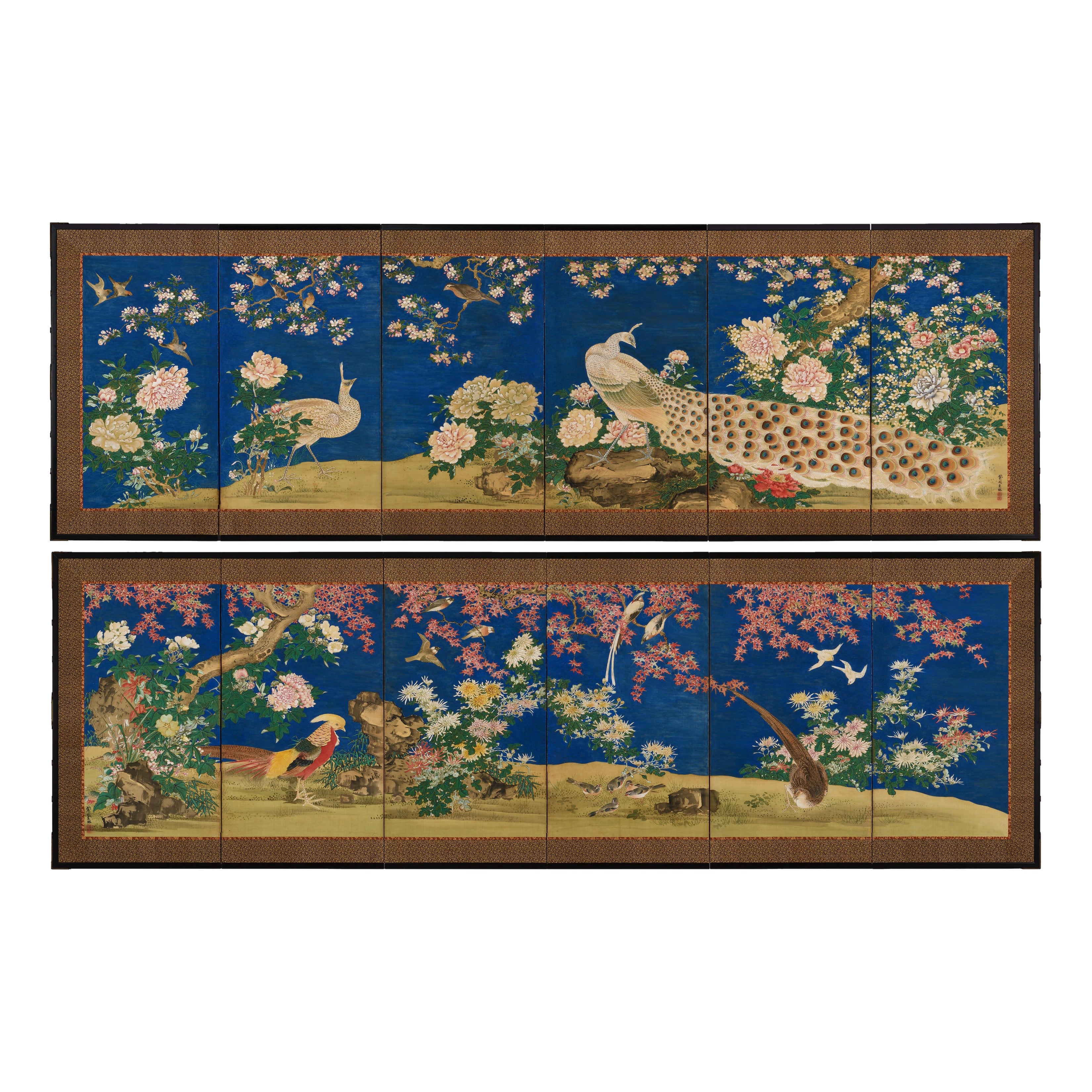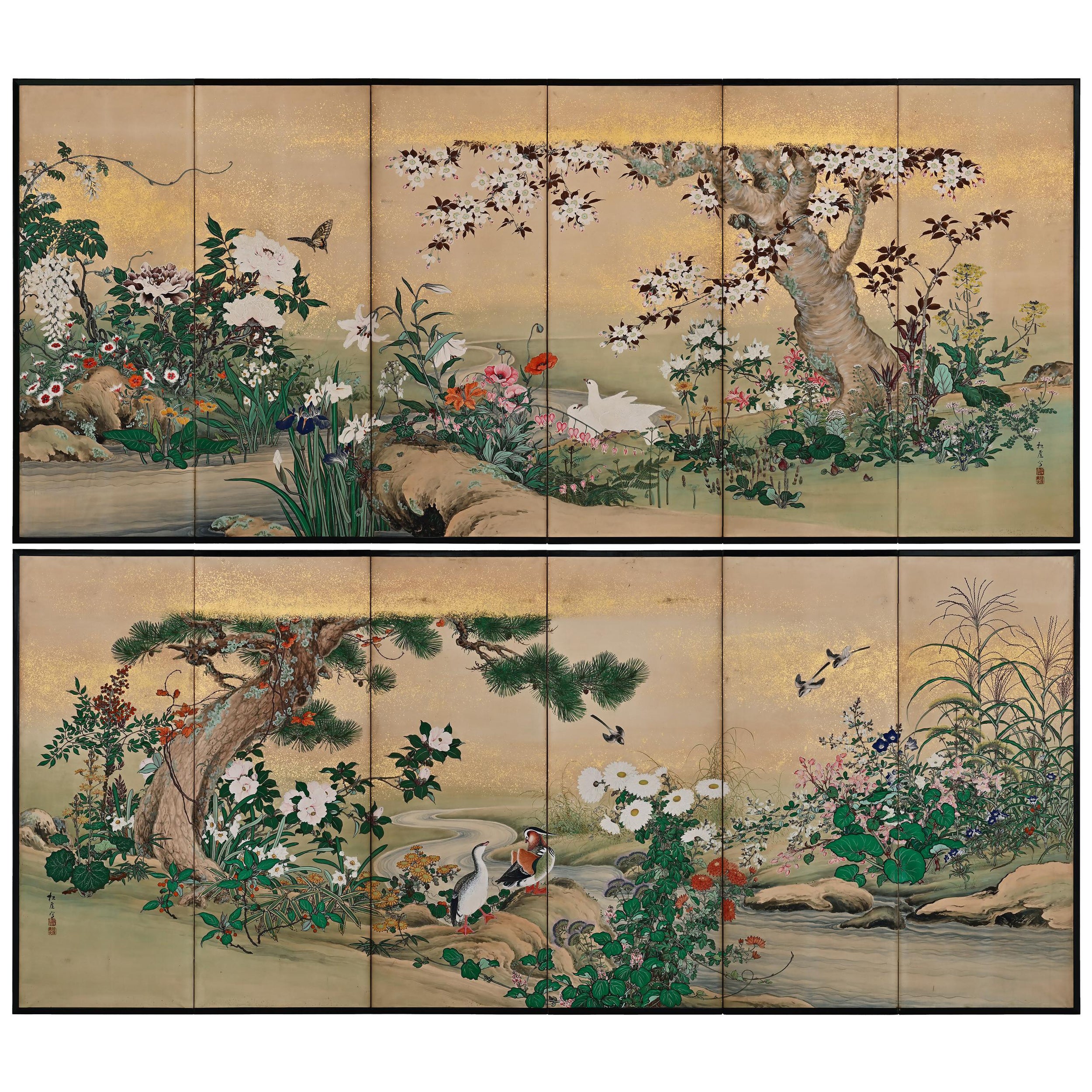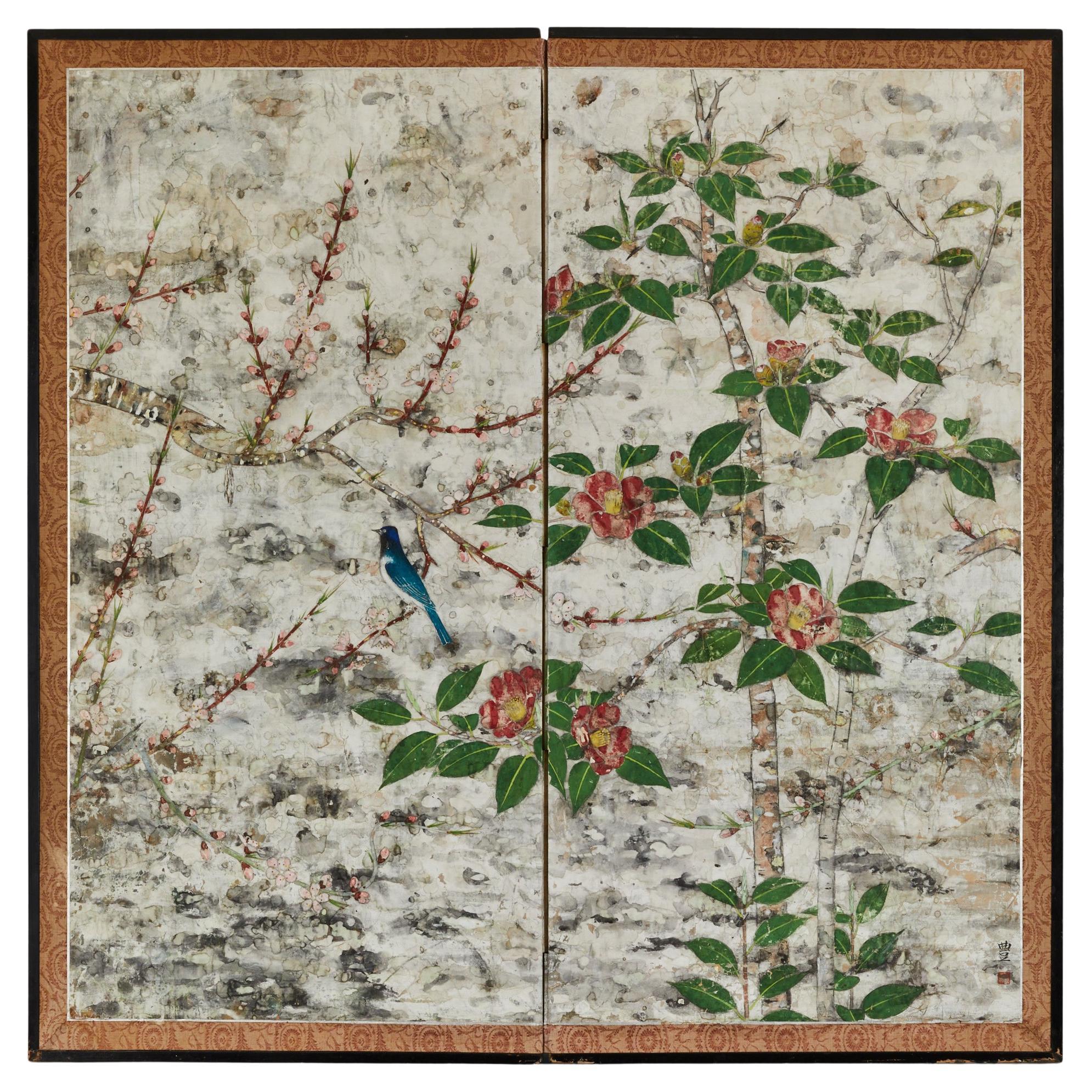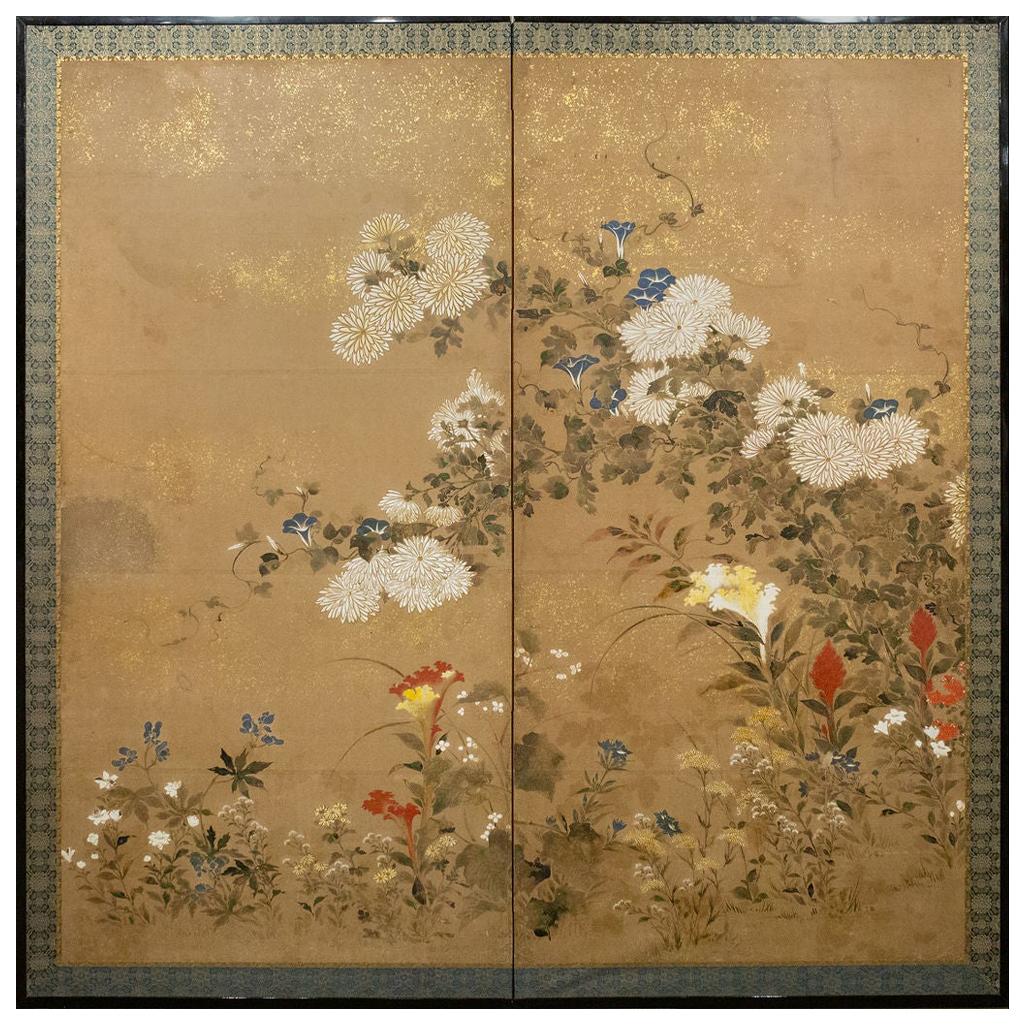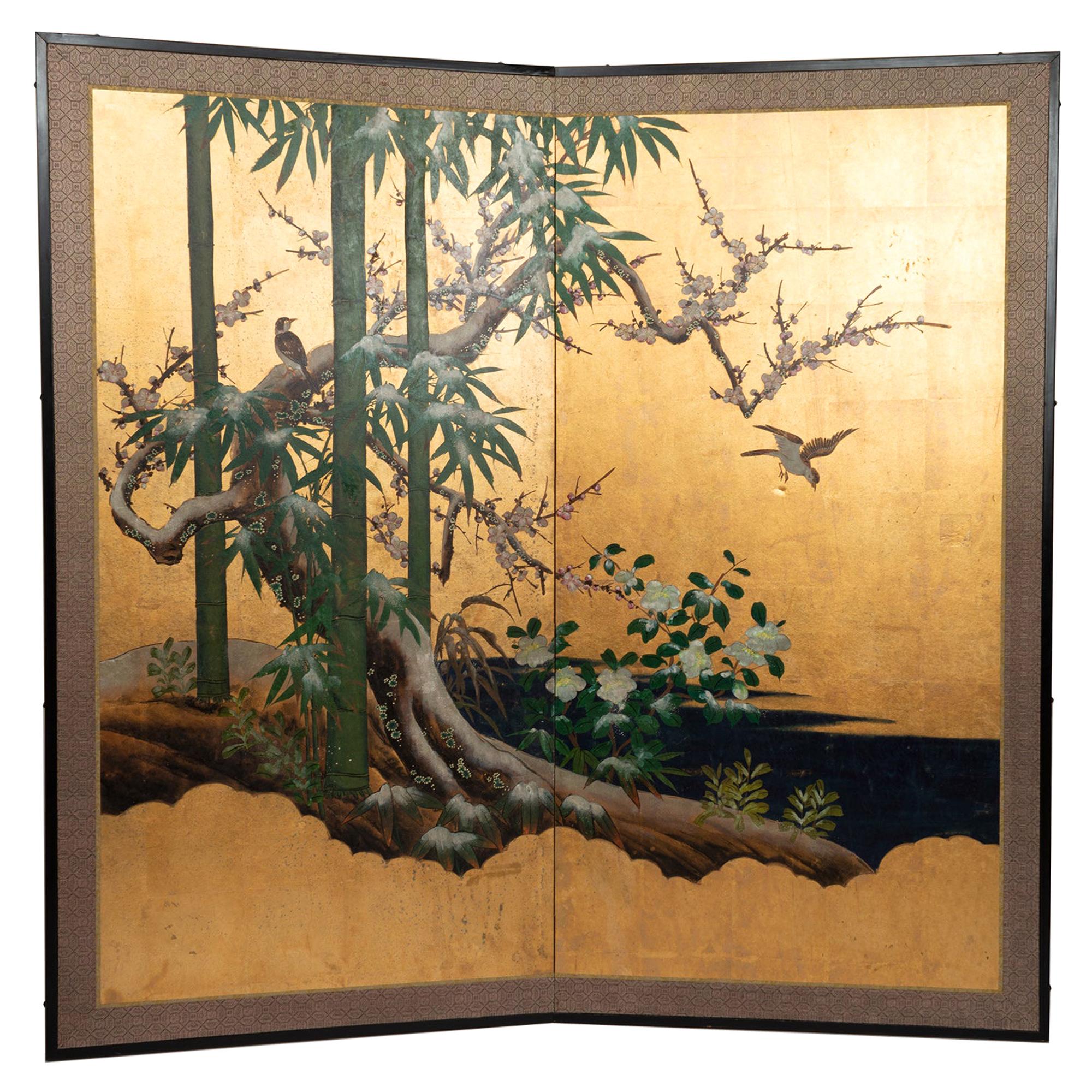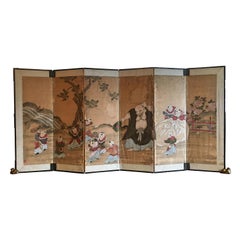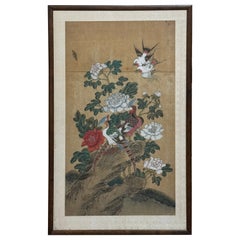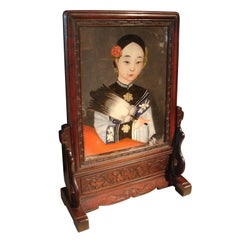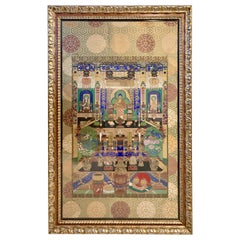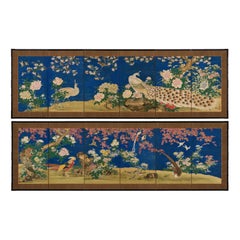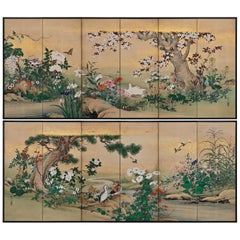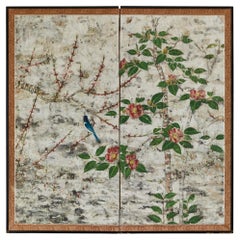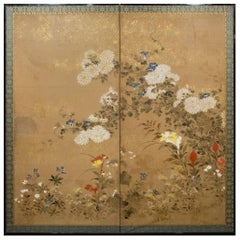Items Similar to Japanese "Magpie and Peony" Two Panel Screen, Edo Period, 18th/19th century
Want more images or videos?
Request additional images or videos from the seller
1 of 11
Japanese "Magpie and Peony" Two Panel Screen, Edo Period, 18th/19th century
$5,900
£4,459.67
€5,124.95
CA$8,215.71
A$9,139.64
CHF 4,791.12
MX$111,684.23
NOK 61,008.89
SEK 57,431.43
DKK 38,255.82
Shipping
Retrieving quote...The 1stDibs Promise:
Authenticity Guarantee,
Money-Back Guarantee,
24-Hour Cancellation
About the Item
A sublime Japanese two panel "Magpie and Peony" screen, ink and color on paper, Edo Period, late 18th or early 19th century, circa 1800, Japan.
The two panel screen features a wonderful scene of blossoming red and white peony growing from a rocky outcrop to one side. The other side with a single charming white-faced magpie perched on a delicate stalk of bamboo overhanging a slow moving stream.
The red and white peonies pop against the neutral ground. The bamboo seems to bend under the minuscule weight of the black and white magpie.
The painting's composition and style is based on Chinese 12th century Song Dynasty bird and flower paintings, and influenced by "one-corner" styles.
As with most Chinese and Japanese paintings, each bird, flower, and plant has a special meaning. In this case, the magpie symbolizes joy and happiness. Bamboo is a sign of resilience and longevity. It is also a homonym for "to wish". Peony is highly regarded with many meanings, including beauty, honor, and wealth. The painting can be read as "wishes for a long and happy life filled with beauty and prosperity".
Mounted as a two panel screen. The painting with a gilt paper border within a fabric brocade border, and framed in black lacquer with metal mounts.
- Dimensions:Height: 24 in (60.96 cm)Width: 68.5 in (173.99 cm)Depth: 0.75 in (1.91 cm)
- Style:Edo (Of the Period)
- Materials and Techniques:
- Place of Origin:
- Period:
- Date of Manufacture:circa 1800
- Condition:Wear consistent with age and use. Minor fading. In overall very good condition.
- Seller Location:Austin, TX
- Reference Number:1stDibs: LU894741996432
About the Seller
5.0
Platinum Seller
Premium sellers with a 4.7+ rating and 24-hour response times
Established in 2001
1stDibs seller since 2010
345 sales on 1stDibs
Typical response time: <1 hour
- ShippingRetrieving quote...Shipping from: Austin, TX
- Return Policy
Authenticity Guarantee
In the unlikely event there’s an issue with an item’s authenticity, contact us within 1 year for a full refund. DetailsMoney-Back Guarantee
If your item is not as described, is damaged in transit, or does not arrive, contact us within 7 days for a full refund. Details24-Hour Cancellation
You have a 24-hour grace period in which to reconsider your purchase, with no questions asked.Vetted Professional Sellers
Our world-class sellers must adhere to strict standards for service and quality, maintaining the integrity of our listings.Price-Match Guarantee
If you find that a seller listed the same item for a lower price elsewhere, we’ll match it.Trusted Global Delivery
Our best-in-class carrier network provides specialized shipping options worldwide, including custom delivery.More From This Seller
View AllJapanese Six Panel Screen with Hotei, Edo Period, Early 19th Century
Located in Austin, TX
A delightful Japanese six panel painted paper screen featuring the beloved figure Hotei, Edo Period, early 19th century.
Hotei, called Budai in China, and known as the Laughing Buddha or Fat Buddha in the West, is considered to be an emanation of Maitreya, the Buddha of the Future.
In Japan, he also holds a special place as one of the Seven Lucky Gods, being the god of fortune, and protector of children.
He is always portrayed as a mirthful and corpulent man, dressed in loose robes that show off his round belly. He carries a sack with him, said to be filled with treasure. As the protector of children, he is often portrayed with them playing on or around him, as he is here. The children portrayed in this screen are dressed in Chinese style clothing...
Category
Antique Early 19th Century Japanese Edo Paintings and Screens
Materials
Silk, Paper
Chinese "Birds and Peony" Ink and Color on Silk Painting, Qing Dynasty, China
Located in Austin, TX
A charming Chinese "Birds and Peony" painting, ink and color on silk, framed and glazed, Qing Dynasty, late 19th century, China.
The delightful and colorful painting features a scen...
Category
Antique Late 19th Century Chinese Qing Paintings and Screens
Materials
Metal
Chinese Reverse Painted Glass and Hardwood Table Screen
Located in Austin, TX
An unusual table screen featuring a reverse glass painted portrait of a young noble lady set into a hardwood frame and stand.
The beautiful maiden has a roun...
Category
Antique Mid-19th Century Chinese Qing Paintings and Screens
Materials
Glass, Hardwood
Large Framed Japanese Buddhist Amida Temple Hall Painting, Mid-19th Century
Located in Austin, TX
A large and incredible Japanese painting of a Buddhist temple hall with Amida Nyorai, late Edo or early Meiji period, mid-19th century, Japan. Mounted wit...
Category
Antique Mid-19th Century Japanese Meiji Paintings and Screens
Materials
Brocade, Silk, Acrylic, Wood, Paint
Tall Vintage Chinese Export Reverse Glass Painted Hardwood Framed Hanging Panel
Located in Austin, TX
A very large vintage Chinese export reverse glass painted figural hanging wall panel in a carved hardwood frame, early to mid-20th century...
Category
Mid-20th Century Chinese Qing Paintings and Screens
Materials
Glass, Hardwood
Japanese Marquetry and Lacquer Jewelry Chest, Meiji Period, circa 1900, Japan
Located in Austin, TX
A very attractive Japanese wood table top jewelry or collector's chest with marquetry and lacquer decoration, Meiji period, circa 1900, Japan. Previously in the collection of Asbjorn Lunde (1927 - 2017).
The chest is crafted in the form of a Chinese seal...
Category
Antique Early 1900s Japanese Meiji Lacquer
Materials
Wood, Softwood, Lacquer
You May Also Like
Mid 19th Century Japanese Screen Pair. Flowers & Birds of the Four Seasons.
Located in Kyoto, JP
Shioka Sorin (1781-1850)
Flowers & Birds of the Four Seasons
Pair of six-panel Japanese Screens. Ink, gofun and pigments on silk.
Dimensions (each screen): H. 91.5cm x W. 285cm (3...
Category
Antique Mid-19th Century Japanese Edo Paintings and Screens
Materials
Silk
19th Century Japanese Screen Pair. Flowers & Birds of the Four Seasons
Located in Kyoto, JP
Flowers & Birds of the Four Seasons
Pair of six-fold Japanese Screens. Ink, color, gofun and gold on paper.
Second half of the 19th Centur...
Category
Antique Late 19th Century Japanese Meiji Paintings and Screens
Materials
Wood, Paper
Japanese Two Panel Screen: Floral Tarashikomi
Located in Hudson, NY
An unusual floral screen covered entirely in the tarashikomi technique of the famed Rimpa School creating an archaic feel. Mineral pigments and ink on silver with a silk brocade bord...
Category
Antique Late 19th Century Japanese Paintings and Screens
Materials
Silver
Japanese Two-Panel Screen, Flower Garden
Located in Hudson, NY
Rimpa School painting featuring cascading chrysanthemums as well as cockscombs, summer wild flowers, and a climbing morning glory vine. Beautifully executed, fine painting in mineral...
Category
Antique Mid-18th Century Japanese Edo Paintings and Screens
Materials
Gold Leaf
Japanese Edo Period Two-Panel Screen with Chrysanthemums
Located in New York, NY
Japanese set of sliding doors that have been mounted as a screen in the early 20th century and the panels from the 19th-century.
ABOUT
This screen is indeed a masterpiece o...
Category
Antique 19th Century Japanese Japonisme Paintings and Screens
Materials
Wood
Antique 19th Century Japanese Two-Panel Screen ‘Byobu’, Kano School, Edo Period
Located in London, GB
Japanese Kano School Edo period two-panel screen depicting flowering prunus and bamboo on a rock formation, with colorful birds next to a body of water. ...
Category
Antique Mid-19th Century Japanese Edo Paintings and Screens
Materials
Gold Leaf
More Ways To Browse
18th And 19th Century Paintings
Antique Fabric Panel
18th Century Bird Painting
Lacquered Red Screens
White Lacquer Asian
Japanese Screens Flowers
Asian Fabric Panels
Chinese Bird And Flowers Painting
Antique Chinese Painting Of Birds
18th Century Hand Screen
Japanese Lacquer Panel Screen
Antique Metal Screen
Chinese Black Lacquered Screen
Antique Japanese Lacquer Screens
Painted Panel Screen Birds
Asian Art Bamboo Frame
Chinese Screen With Birds
Asian Paintings On Fabric
